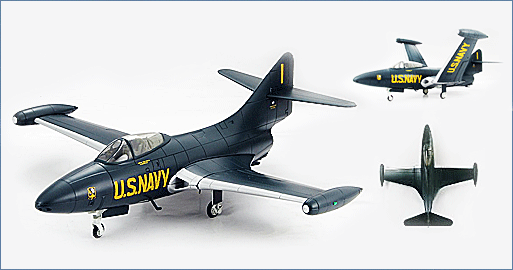Air Power Series>1:48 die-cast display model>F9F>HA7204
Grumman F9F-2 LCDR R.E. "Dusty" Rhodes, Team Leader of "Blue Angels", 1949

General Background
The F9F Panther entered service in 1949. It was the first Grumman jet fighter, first Carrier-Borne Navy jet fighter in combat, first USN jet to shoot down an enemy airplane, first jet aircraft used by the Blue Angels. A total of 1,382 F9Fs were made. VF-781 was the first squadron to volunteer for combat in Korea and were 100% volunteers earning them the name “Pacemakers”. The F9F flew 78,000 sorties with VF-781 flying 2,721 of them without a single loss of life. The Panther was removed from front-line service in 1956
The Aircraft
In June 1946 the “Blue Angels” first leader was LCDR Roy “Butch” Voris and they flew 3 Grumman F6F Hellcats. Voris chose “Blue Angels” after seeing an ad for a New York nightclub of the same name. Only two months later the team transitioned to the F8F Bearcat. In 1947 Dusty Rhodes joined the Blue Angels along with a new leader LCDR Robert Clarke. Clarke added a 4th aircraft to the team. On January 9, 1948 Rhodes became the leader until January 11, 1950. During his tenure the Blue Angels moved to its first jet aircraft the Grumman F9F-2 Panther.
Specifications :
Engine: |
1 X Pratt & Whitney J42-P-6/P-8 turbojet |
| Rated at – 5,000 lb.s.t. for takeoff dry | |
| 5,950 lb.s.t. for takeoff with water injection | |
| Performance: | Maximum speed – 575 mph at sea level, 545 mph at 22,000 feet, 529 mph at 3,500 feet |
| Cruising speed – 487 mph | |
| Landing speed - 105 mph | |
| Initial climb rate – 5,140 feet per minute | |
| Service ceiling – 44,600 feet | |
| Normal range – 1,353 miles | |
| Dimensions: | Wingspan - 35 feet 3 inches |
| Length - 37 feet 3 inches | |
| Height - 11 feet 6 inches | |
| Wing area - 250 square feet. | |
| Weights: | Empty – 9,303 pounds |
| Combat - 14,235 pounds | |
| Gross - 16,450 pounds | |
| Take-off - 19,494 pounds maximum | |
| Internal fuel capacity: | 923 US gallons |
| Armament: | 4 X 20-mm cannon. |
| Under-wing loads of up to 2,000 pounds of bombs | |
| and rockets could be carried on eight under-wing racks. |

